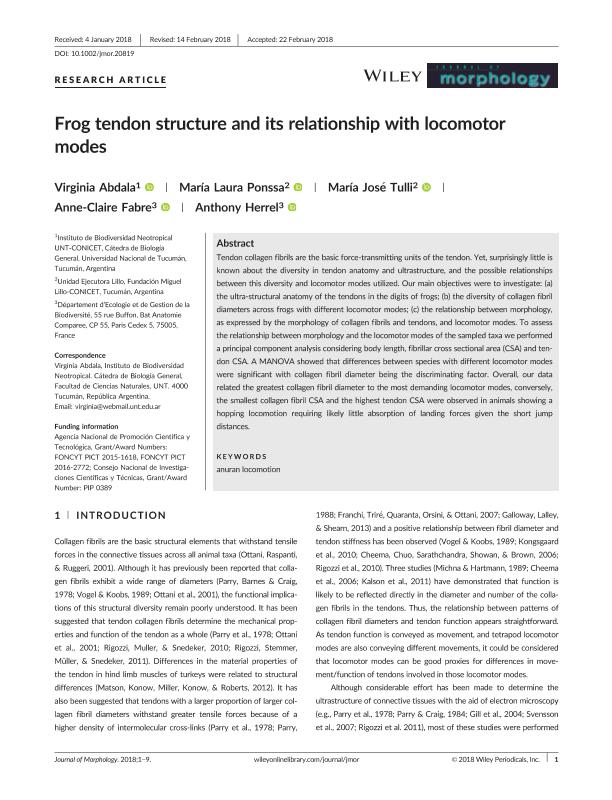Mostrar el registro sencillo del ítem
dc.contributor.author
Abdala, Virginia Sara Luz
dc.contributor.author
Ponssa, María Laura

dc.contributor.author
Tulli, María José

dc.contributor.author
Fabre, Anne Claire
dc.contributor.author
Herrel, Anthony
dc.date.available
2019-10-18T13:44:50Z
dc.date.issued
2018-03
dc.identifier.citation
Abdala, Virginia Sara Luz; Ponssa, María Laura; Tulli, María José; Fabre, Anne Claire; Herrel, Anthony; Frog tendon structure and its relationship with locomotor modes; Wiley-liss, Div John Wiley & Sons Inc; Journal of Morphology; 279; 7; 3-2018; 895-903
dc.identifier.issn
0362-2525
dc.identifier.uri
http://hdl.handle.net/11336/86300
dc.description.abstract
Tendon collagen fibrils are the basic force‐transmitting units of the tendon. Yet, surprisingly little is known about the diversity in tendon anatomy and ultrastructure, and the possible relationships between this diversity and locomotor modes utilized. Our main objectives were to investigate: (a) the ultra‐structural anatomy of the tendons in the digits of frogs; (b) the diversity of collagen fibril diameters across frogs with different locomotor modes; (c) the relationship between morphology, as expressed by the morphology of collagen fibrils and tendons, and locomotor modes. To assess the relationship between morphology and the locomotor modes of the sampled taxa we performed a principal component analysis considering body length, fibrillar cross sectional area (CSA) and tendon CSA. A MANOVA showed that differences between species with different locomotor modes were significant with collagen fibril diameter being the discriminating factor. Overall, our data related the greatest collagen fibril diameter to the most demanding locomotor modes, conversely, the smallest collagen fibril CSA and the highest tendon CSA were observed in animals showing a hopping locomotion requiring likely little absorption of landing forces given the short jump distances.
dc.format
application/pdf
dc.language.iso
eng
dc.publisher
Wiley-liss, Div John Wiley & Sons Inc

dc.rights
info:eu-repo/semantics/openAccess
dc.rights
Atribución-NoComercial-CompartirIgual 2.5 Argentina (CC BY-NC-SA 2.5 AR)
dc.rights.uri
https://creativecommons.org/licenses/by-nc-sa/2.5/ar/
dc.subject
ANURAN LOCOMOTION
dc.subject.classification
Otros Tópicos Biológicos

dc.subject.classification
Ciencias Biológicas

dc.subject.classification
CIENCIAS NATURALES Y EXACTAS

dc.title
Frog tendon structure and its relationship with locomotor modes
dc.type
info:eu-repo/semantics/article
dc.type
info:ar-repo/semantics/artículo
dc.type
info:eu-repo/semantics/publishedVersion
dc.date.updated
2019-10-16T19:13:24Z
dc.journal.volume
279
dc.journal.number
7
dc.journal.pagination
895-903
dc.journal.pais
Estados Unidos

dc.journal.ciudad
New York
dc.description.fil
Fil: Abdala, Virginia Sara Luz. Consejo Nacional de Investigaciones Científicas y Técnicas. Centro Científico Tecnológico Conicet - Tucumán. Instituto de Biodiversidad Neotropical. Universidad Nacional de Tucumán. Facultad de Ciencias Naturales e Instituto Miguel Lillo. Instituto de Biodiversidad Neotropical. Instituto de Biodiversidad Neotropical; Argentina
dc.description.fil
Fil: Ponssa, María Laura. Consejo Nacional de Investigaciones Científicas y Técnicas. Centro Científico Tecnológico - Tucumán. Unidad Ejecutora Lillo; Argentina
dc.description.fil
Fil: Tulli, María José. Fundación Miguel Lillo. Dirección de Zoología. Instituto de Herpetología; Argentina
dc.description.fil
Fil: Fabre, Anne Claire. Consejo Nacional de Investigaciones Científicas y Técnicas. Centro Científico Tecnológico - Tucumán. Unidad Ejecutora Lillo; Argentina
dc.description.fil
Fil: Herrel, Anthony. Département D'ecologie Et de Gestion de la Biodiversité; Francia
dc.journal.title
Journal of Morphology

dc.relation.alternativeid
info:eu-repo/semantics/altIdentifier/url/https://doi.wiley.com/10.1002/jmor.20819
dc.relation.alternativeid
info:eu-repo/semantics/altIdentifier/url/https://onlinelibrary.wiley.com/doi/abs/10.1002/jmor.20819
Archivos asociados
